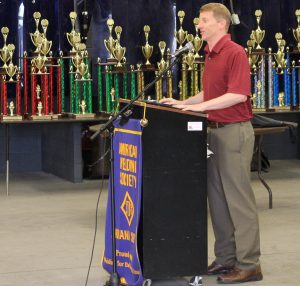Presentation at the 2017 AWS Midwest Welding Competition
The following condensed presentation by Fritz Prine was delivered to about 140 students and instructors for the American Welding Soceity’s 2017 Midwest Welding Competition and Show. It was held at the J. Everett Light Career Center in Indianapolis, IN on April 28, 2017.
I am Fritz Prine, President of Westfield Steel. I am here with my Production Manager, Jack Laudig. We have been supporting the local chapter of the American Welding Society for over 20 years. I am here to speak to you about where we are in steel and manufacturing today. We are in an interesting time for students, and I want to highlight some major trends in U.S. manufacturing: Jobs, Technological change, and Opportunity.
Over the past 50 years, manufacturing has changed just as everything in our world has changed. Just as each of us uses technology more and more, businesses also use technology to produce things better, cheaper, or more efficiently. The technology used in manufacturing has increased continuously. Think of computers, software, automation, and robotics. Many industrial jobs have disappeared over the past 50 years, 20 years, 10 years, and even the past 5 years. Those jobs will not be coming back. Another trend is that many industrial jobs have been occupied by skilled workers who are retiring. There is a huge gap in the knowledge and skills of today’s workers entering the field. Here is your opportunity. You are learning those skills, so keep working at it.
I don’t want to sound too negative. The state of U.S. manufacturing is not all bad. Many products are still made of metal and steel. 
At our company, Westfield Steel, we are trying to be a company that still makes these products in the U.S. using people and technology together.
Many skills that you use today, 1 year from now, or even 5 years from now will be much different than those skills needed in the past.
- The key for you is focus on learning, be curious with technology, and work hard.
- You will have to adapt more quickly than others in the past.
- Make your opportunity.
Examples of changes in technology just in a steel service center. Technology is also tools.
- CNC machines have been around for over 50 years. The tools and capabilities have evolved over time to be faster and more flexible. These machines reduced the need for people. At Westfield Steel, one example is that we have evolved from cutting steel with a hand torch to oxy-fuel burn table to high-definition plasma table and now to laser.
- Robotics – The first commercial robot was from 1956. It was not until the 1970’s that manufacturers figured out how to use robotic arms for industrial production. Now, we see it in machining, welding, painting, assembly and material handling. Every major automaker has more robotic arms in welding and assembly than people. Think about that. Here is a data point. In the year 2000, there were about 100,000 industrial robots being produced in the world. In the year 2015, there were 254,000. Today, the current estimate is that there are 1.6 million industrial robots in operation worldwide. At Westfield Steel, we have evolved from hand welding then using fixtures à stud welding then our R-12 machine with feeder bowls and now robotic welding arms.
- 3-D Printing – Actually began in the 1980’s and started with plastics. In was not long until metal was being used. There are a lot of processes that people call 3-D printing. For metal, it is sintering or additive manufacturing. Now, large companies like General Electric have created an entire division that only makes metal parts from 3-D printing. In 2016, they made 1 fuel nozzle for a light aircraft engine. This replaced 20 other parts. For 2017, they expect to make 15 new parts that replace 800 other parts. Think about what companies or who made those 800 other parts. GE believes that they will save billions of dollars over the next 5 years.
- Software and computers – Think about the changes that you have seen in the phones, pcs, gaming, and apps just in your young lives. At Westfield Steel, we started with paper and pencil and no computers in the 1980’s. We evolved to desktop computers and a software system in the 1990’s to new system in 2000’s with faster computers, CAD and nesting software to now with new integrated Microsoft software that runs the entire company and operators have technology in their hands to move production through the process. Our drivers now using GPS data collection devices integrated into the engine for safety and efficiency. We now have electronic logging for DOT compliance reducing paper. All of our employees use interactive safety training with on-line modules to improve.
- Welding trends – You may have learned history from your instructors. TIG and MIG were not advanced enough to work well until the 1940’s. Laser beam welding started in the 1960’s. Robotic welding grew in the 1990’s. Future will have different weldable metals, growth in alloy welding, and embedding computer chips into the steel to monitor the weldment over its life.
Where are your opportunities?
- As each of these tools becomes more integrated and automated, there are fewer operators. However, the operators become more critical and valuable to the success of the process.

- If you understand how to use these tools, you become more valuable. Understand both the operation and the programming.
- You need to be comfortable and accomplished using technology.
- Wages will be higher, but the expectations are high. You can’t just show up.
As I mentioned before, the skills that you use today and in the future are much different than the past. Focus on learning technology, work hard, adapt, make your opportunity.
Back
